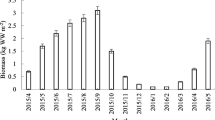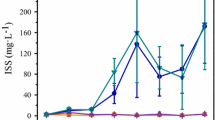Abstract
Enrichment of waterways with nitrogen (N) and phosphorus (P) has accelerated eutrophication and promoted cyanobacterial blooms worldwide. An understanding of whether cyanobacteria maintain their dominance under accelerated eutrophication will help predict trends and provide rational control measures. A mesocosm experiment was conducted under natural light and temperature conditions in Lake Taihu, China. It revealed that only N added to lake water promoted growth of colonial and filamentous cyanobacteria (Microcystis, Pseudoanabaena and Planktothrix) and single-cell green algae (Cosmarium, Chlorella, and Scenedesmus). Adding P alone promoted neither cyanobacteria nor green algae significantly. N plus P additions promoted cyanobacteria and green algae growth greatly. The higher growth rates of green algae vs. cyanobacteria in N plus P additions resulted in the biomass of green algae exceeding that of cyanobacteria. This indicates that further enrichment with N plus P in eutrophic water will enhance green algae over cyanobacterial dominance. However, it does not mean that eutrophication problems will cease. On the contrary, the risk will increase due to increasing total phytoplankton biomass.





Similar content being viewed by others
References
Agusti S, Duarte CM, Canfield DE (1990) Phytoplankton abundance in Florida lakes: evidence for the frequent lack of nutrient limitation. Limnol Oceanogr 35(1):181–188
Bergquist A, Carpenter S (1986) Limnetic herbivory: effects on phytoplankton populations and primary production. Ecology 67(5):1351–1360
Brookes JD, Carey CC (2011) Resilience to blooms. Science 334:46–47
Brown JH, Gillooly JF, Allen AP, Savage VM, West GB (2004) Toward a metabolic theory of ecology. Ecology 85(7):1771–1789
Canfield DE, Glazer AN, Falkowski PG (2010) The evolution and future of Earth’s nitrogen cycle. Science 330(6001):192–196
Chen Y, Qin B, Teubner K, Dokulil MT (2003) Long-term dynamics of phytoplankton assemblages: microcystis-domination in Lake Taihu, a large shallow lake in China. J Plankton Res 25(4):445–453
Chen B, Xu Z, Zhou Q, Chen C, Gao Y, Yang S, Ji W (2010) Long-term changes of phytoplankton community in Xiagu waters of Xiamen, China. Acta Oceanol Sin 29(6):104–114
Chisholm SW (1992) Phytoplankton size. Primary productivity and biogeochemical cycles in the sea. Plenum, 213–237
Conley JD, Paerl HW, Howarth RW, Boesch DF, Seitzinger SP, Havens KE, Lancelot C, Likens GE (2009) Controlling eutrophication: nitrogen and phosphorus. Science 323(5917):1014–1015
Cyr H, Curtis JM (1999) Zooplankton community size structure and taxonomic composition affects size-selective grazing in natural communities. Oecologia 118(3):306–315
Downing JA, Watson SB, McCauley E (2001) Predicting cyanobacteria dominance in lakes. Can J Fish Aquat Sci 58(10):1905–1908
Edwards KF, Klausmeier CA, Litchman E (2011) Evidence for a three-way trade-off between nitrogen and phosphorus competitive abilities and cell size in phytoplankton. Ecology 92(11):2085–2095
Elser JJ, Bracken ME, Cleland EE, Gruner DS, Harpole WS, Hillebrand H, Ngai JT, Seabloom EW, Shurin JB, Smith JE (2007) Global analysis of nitrogen and phosphorus limitation of primary producers in freshwater, marine and terrestrial ecosystems. Ecol Lett 10(12):1135–1142
Fenchel T (1974) Intrinsic rate of natural increase: the relationship with body size. Oecologia 14(4):317–326
Hu HJ, Li Y, Wei H, Zhu J (1980) Freshwater algae in China. Shanghai Science and Technology Press, Beijing
Jensen J, Jeppesen E, Olrik K, Kristensen P (1994) Impact of nutrients and physical factors on the shift from cyanobacterial to chlorophyte dominance in shallow Danish lakes. Can J Fish Aquat Sci 51(8):1692–1699
Kearns KD, Hunter MD (2001) Green algal extracellular products regulate antialgal toxin production in a cyanobacterium. Environ Microbiol 2(3):291–297
Kiørboe T (1993) Turbulence, phytoplankton cell size, and the structure of pelagic food webs. Adv Mar Biol 29(1):1–72
Knoechel R, Kalff J (1975) Algal sedimentation: the cause of a diatom-blue-green succession. Verhandlungen Internationale Vereinigung Limnologie 19:745–754
Li M, Zhu W, Gao L, Lu L (2013) Changes in extracellular polysaccharide content and morphology of Microcystis aeruginosa at different specific growth rates. J Appl Phycol 25(4):1023–1230
Litchman E, Klausmeier CA, Schofield OM, Falkowski PG (2007) The role of functional traits and trade-offs in structuring phytoplankton communities: scaling from cellular to ecosystem level. Ecol Lett 10(12):1170–1181
Ma J, Brookes JD, Qin B, Paerl HW, Gao G, Wu P (2014) Environmental factors controlling colony formation in blooms of the cyanobacteria Microcystis spp. in Lake Taihu, China. Harmful Algae 31:136–142
Marañón E, Cermeño P, López-Sandoval DC, Rodríguez-Ramos T, Sobrino C, Huete-Ortega M, Blanco JM, Rodríguez J (2013) Unimodal size scaling of phytoplankton growth and the size dependence of nutrient uptake and use. Ecol Lett 16(3):371–379
Morita RY (1975) Psychrophilic bacteria. Bacteriol Rev 39(2):144–167
Munoz R, Guieysse B (2006) Algal–bacterial processes for the treatment of hazardous contaminants: a review. Water Res 40(15):2799–2815
Oliver RL, Hamilton DP, Brookes JD, Ganf GG (2012) Physiology, blooms and prediction of planktonic cyanobacteria, Ecology of Cyanobacteria II. Springer, pp. 155–194
Paerl HW, Hall NS, Calandrino ES (2011a) Controlling harmful cyanobacterial blooms in a world experiencing anthropogenic and climatic-induced change. Sci Total Environ 409(10):1739–1745
Paerl HW, Xu H, McCarthy MJ, Zhu G, Qin B, Li Y, Gardner WS (2011b) Controlling harmful cyanobacterial blooms in a hyper-eutrophic lake (Lake Taihu, China): the need for a dual nutrient (N & P) management strategy. Water Res 45(5):1973–1983
Paerl HW, Xu H, Hall NS, Zhu G, Qin B, Wu Y, Rossignol KL, Dong L, McCarthy MJ, and Joyner AR (2014) Controlling cyanobacterial blooms in hypertrophic Lake Taihu, China: will nitrogen reductions cause replacement of non-N2 fixing by N2 fixing taxa? PLoSOne (In Press)
Pápista É, Acs E, Böddi B (2002) Chlorophyll-a determination with ethanol—a critical test. Hydrobiologia 485(1):191–198
Pick FR, Lean DR (1987) The role of macronutrients (C, N, P) in controlling cyanobacterial dominance in temperate lakes. N Z J Mar Freshw Res 21(3):425–434
Reynolds C (1988) Functional morphology and the adaptive strategies of freshwater phytoplankton. Growth and reproductive strategies of freshwater phytoplankton. Cambridge University Press, Cambridge, pp 388–433
Reynolds CS (2006) The ecology of phytoplankton. Cambridge University Press
Reynolds CS, Oliver RL, Walsby AE (1987) Cyanobacterial dominance: the role of buoyancy regulation in dynamic lake environments. N Z J Mar Freshw Res 21(3):379–390
Scheffer M, Rinaldi S, Gragnani A, Mur LR, van Nes EH (1997) On the dominance of filamentous cyanobacteria in shallow, turbid lakes. Ecology 78(1):272–282
Smith VH (1986) Light and nutrient effects on the relative biomass of blue-green algae in Lake Phytoplankton. Can J Fish Aquat Sci 43(1):148–153
Steinberg C, Hartmann H (1988) Planktonic bloom-forming Cyanobacteria and the eutrophication of lakes and rivers. Freshw Biol 20(2):279–287
Tilman D (1976) Ecological competition between algae: experimental confirmation of resource-based competition theory. Science 192(4238):463–465
Trimbee AM, Prepas E (1987) Evaluation of total phosphorus as a predictor of the relative biomass of blue-green algae with emphasis on Alberta lakes. Can J Fish Aquat Sci 44(7):1337–1342
Watson S, McCauley E, Downing JA (1992) Sigmoid relationships between phosphorus, algal biomass, and algal community structure. Can J Fish Aquat Sci 49(12):2605–2610
Wilson AE, Kaul RB, Sarnelle O (2010) Growth rate consequences of coloniality in a harmful phytoplankter. PLoS One 5(1):1–8
Wu X, Kong F (2009) Effects of light and wind speed on the vertical distribution of Microcystis aeruginosa colonies of different sizes during a summer bloom. Int Rev Hydrobiol 94(3):258–266
Xu H, Paerl HW, Qin B, Zhu G, Gao G (2010) Nitrogen and phosphorus inputs control phytoplankton growth in eutrophic Lake Taihu, China. Limnol Oceanogr 55(1):420–432
Yamamoto Y, Shiah F-K, Chen Y-L, (2011) Importance of large colony formation in bloom-forming cyanobacteria to dominate in eutrophic ponds, Annales de Limnologie-International Journal of Limnology. Cambridge Univ Press, pp. 167–173
Acknowledgments
We are grateful to all the staff in Taihu Laboratory for Lake Ecosystem Research (TLLER). This work was supported by the National Natural Science Foundation of China (nos. 41230744 and 41271355), The Major Projects on Control and Rectification of Water Body Pollution (2014ZX07104-006), and USA National Science Foundation Grants No. ENG/CBET 0826819 and 1230543 and DEB 1240851 Dimensions in Biodiversity.
Author information
Authors and Affiliations
Corresponding author
Additional information
Responsible editor: Philippe Garrigues
Rights and permissions
About this article
Cite this article
Ma, J., Qin, B., Paerl, H.W. et al. Green algal over cyanobacterial dominance promoted with nitrogen and phosphorus additions in a mesocosm study at Lake Taihu, China. Environ Sci Pollut Res 22, 5041–5049 (2015). https://doi.org/10.1007/s11356-014-3930-4
Received:
Accepted:
Published:
Issue Date:
DOI: https://doi.org/10.1007/s11356-014-3930-4




